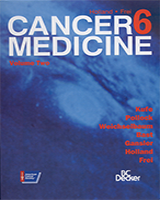By agreement with the publisher, this book is accessible by the search feature, but cannot be browsed.
NCBI Bookshelf. A service of the National Library of Medicine, National Institutes of Health.
Kufe DW, Pollock RE, Weichselbaum RR, et al., editors. Holland-Frei Cancer Medicine. 6th edition. Hamilton (ON): BC Decker; 2003.

Holland-Frei Cancer Medicine. 6th edition.
Show detailsThe identification of novel, clinically active agents has been central to progress in cancer chemotherapy. Examples of new agents, and of areas and targets being mined for new agents are presented in Table 44-1. The optimal use of such agents, of which more than 40 have been identified over the past 50 years, has been crucial.
Table 44-1
Molecular Targets for Cancer Treatment.
Dose is a significant determinant of the antitumor activity and toxicology for the “classical” established cytotoxic chemotherapeutic agents.1 Higher doses (1.2- to twofold) made possible by growth factors (G-CSF, GM-CSF) are variably more effective. High-dose stem cell protection (four- to tenfold) therapy, made possible by hematopoietic stem cell support, has proven that cure can be achieved for selected hematological neoplasms. The effect of dose for biotherapeutic agents and hormones is complex and is currently under study.
The schedule of drug administration may be important to the therapeutic index independent of dose. For example, cytokinetic studies relating to drug schedule have led to the improved use of agents such as cytosine arabinoside (cytarabine, ara-C) in both experimental and clinical leukemia (see below). 2, 3 Combination chemotherapy has been crucial in the development of curative regimens for hematologic malignancies, pediatric solid tumors, testis cancer, and ovarian cancer, and to the adjuvant regimens for breast, lung, bowel cancer, and osteosarcomas.4, 5 The rationale for combination chemotherapy is complex and is dealt with under the various topical headlines. The principal rationale(s) include (1) the pragmatic-almost all therapy that has proven curative in the clinic involves the use of agents in combination (Table 44-2), and (2) the fact that genetic instability results in tumor cell heterogeneity.6–8
Table 44-2
Number of Agents and Curative Treatment for Childhood Acute Lymphoblastic Leukemia (ALL).
Although dose and combination chemotherapy are generally considered separately, they have an important and complex relationship.9, 10 There is currently an impressive increase in the number of putative molecular targets for cancer treatment development (see Table 44-1). A major clinical research challenge will be not only to maximize the effectiveness of individual agents but, particularly, to integrate these drugs into optimal combination strategies.
Contents
- Dose
- Schedule of Drug Administration
- Combination Chemotherapy
- References
- Principles of Dose, Schedule, and Combination Therapy - Holland-Frei Cancer Medi...Principles of Dose, Schedule, and Combination Therapy - Holland-Frei Cancer Medicine
Your browsing activity is empty.
Activity recording is turned off.
See more...